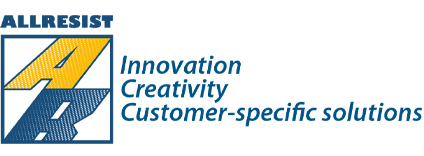Contact exposure
Contact exposure refers to a process in which a photo mask and a substrate are brought into direct contact. This procedure leads to the best resolution of all shadow projections, since diffraction and the associated loss of resolution is reduced to a minimum, depending on the respective resist thickness. The direct contact however entails disadvantages – the resist film is easily damaged by the mask, which may result in transmission errors. In addition, the mask may stick to an insufficiently dried resist (see Wiki “Positive and negative resists for contact exposure“).
Therefore, in the process of contact exposure, a complete drying of the resist layer is essential. Even small traces of solvent in the resist layer can cause sticking and contamination of the photomask. Allresist offers special positive resists from the series AR-P 3740 and special negative resists from the series AR-N 4340, which possess quicker and complete drying behavior thanks to a special solvent mixture. Thus, sticking during the exposure process can be eliminated.
Proximity exposure
Proximity exposure is similar to contact exposure, but the mask is here positioned above the photo resist in a distance of approximately 10 – 50 m m. Damages of photoresist or mask can thus be avoided.
Projection exposure
For contact or proximity exposure, a photomask is projected in a scale of 1:1 onto the photoresist. For projection exposure however, the mask patterns are scaled down using a particular line system (e.g. at a scale of 4:1 or 5:1). The photomasks which are used for this purpose are easier and cheaper to produce, since the structural elements on these masks are several times larger. A further advantage is that particles which have stettled on a photomask exhibit only a minor influence on the generated structures, since these particles are also scaled down accordingly. Since the projection of a mask is not able to cover the entire wafer during projection exposure, the wafers consequently have to be tracked and aligned with extremely precise mechanisms (wafer stepper). Due to the limited depth of focus of the imaging optics is this method in contrast to contact exposure procedures only suitable for the exposure of thin resist films.
Immersion Lithography
The immersion lithography is basically equivalent to projection lithography, with the difference that the gap between projection lens and the photoresist is filled with a liquid medium like e.g. water instead of air. The higher refractory index of the liquid as compared to air increases the numeric aperture of the imaging equipment, which allows the generation of smaller structures.
Greyscale lithography
Greyscale lithography allows the manufacture of 3D-structures. The surface topology can in this case be influenced in a highly specific manner by a lateral variation of the exposure dose, taking advantage of the monotonic but nonlinear development process during the exposure of photoresists. A variable exposure dose can be realised by multiple exposure steps or also using grey scale photo masks which show different degrees of transmission in different areas. If multiple exposure steps are applied, the mask is, depending on the desired structure, either shifted stepwise or several binary masks with different grey shades are used. The exposure dose can furthermore be varied accordingly (see also Resist-Wiki “Diffractive optics with “analogous“ e-beam resist“).
Laser exposure
Photo-sensitive resists can also be processed with laser light. If the applied laser wavelength is in the absorption range of the photoresist, operating in the cw (continuous wave) mode is generally possible. Due to the high energy densities, structures can be written with very high velocities and high precision. If ultra-short laser pulses are used (fs – ps-range), photoresist can also be processed beyond their absorption range. This means that the light-sensitive medium is highly transparent for the laser light applied. If however a laser beam operating in the pulsed mode is tightly focused, multi-photon absorption events (primarily 2-photon absorption) may occur at the focal spot of the laser which cause a chemical or physical modification at the focal spot and thus allows a structuring of the resist (see NIR-Resist Resist-Wiki or AR NEWS, 26 th issue). It is thus possible to generate basically any 3D-structure using different light-sensitive materials.
X-ray lithography
Similar to conventional photolithography, also for X-ray lithography an intensive and narrow-band monochromatic radiation is required. The wave length of soft X-ray radiation is in a range of 10–0.1 nm. Suitable radiation sources are high-power X-ray tubes or also synchrotron radiation sources. Synchrotron radiation as for example generated at the BESSY is characterised by high intensity and extreme brilliance of the emitted radiation, thus allowing for a relatively rapid exposure. Very small structures in a range of less than 20 nm can be realised with high depth of field. While optical lithography uses chemical reactions induced directly by incoming photons, chemical reactions in X-ray lithography are induced by secondary electrons (photo and Auger electrons) which are generated and interact with the resist material. The production of masks is technically demanding, since X-ray beams can’t be focused by classical lenses. X-ray lithography is among others used within the scope of LIGA-procedures for the generation of three-dimensional structures with high aspect ratio for applications in micro systems technology. (See CAR 44 and AR NEWS, 21 st issue.)
